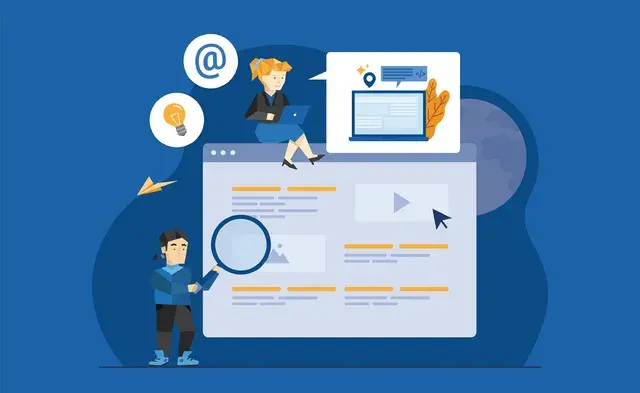9 Ways to Use Your Website to Actually Close Sales

In the current era of digital marketing, consumers are more skeptical than ever before. The internet is chock-full of ads and web content designed to lead people to a sale, which your average web user will become more aware of as time passes. But all this doesn’t change the fact that the internet is still hands-down the best place to reach your target audience, no matter who they are. It just means you have to go about your online marketing in a specific way if you want to not only connect with people, but nurture them into becoming customers.
One of the areas that requires a thoughtful approach is your company website. When created properly, a business page can not only draw in brand new leads, but help nurture existing prospects into customers. Here are the top tips on how to leverage your website to close sales, instead of just looking nice.
Involve All Departments When Creating or Updating the Company Website
Think about a typical customer’s experience with your business. At the beginning, they might interact mostly with marketing. Later, they’ll be referred to a salesperson. When they decide to make a purchase, they may have an account manager or onboarding specialist. If they run into any issues with your offering, they’ll probably speak with a customer service representative or team.
The Greater the Input the Greater the Adoption
Since many different departments are involved in a typical customer lifecycle, consider involving all of them to build your website. Sadly, many businesses today make the mistake of leaving the creation of their website to the marketing team. Other team members in your company need to share their customer knowledge so that your site is well-rounded and speaks to every experience a customer has with your business.
Publish Content That Supports Your Sales Cycle and Buyer’s Journey
Just like your marketing strategy in general, your website should include content that is mapped to the buyer’s journey. There are a few simple ways to accomplish this.
What Questions are Prospects Constantly Asking Your Sales Team?
One easy way to ensure your website is on the right track to close more leads is to use it to answer questions that prospects ask about your business. Addressing these concerns is easy – just talk to your salespeople and find at least three to five questions that prospects commonly ask before they become customers. Then, put content on your site that answers these questions.
What Resources Would It Be Great To Have Available As A Ready To Go Link?
When people are buying a certain class of a product or service, there are some common things they need to help them through their purchasing decision. For example, if you were buying a car for your family, you’d be interested in the results of safety tests. A wise seller would include this information directly on their website, to help you make your decision. This can be applied to almost any type of purchase – think about the kind of information your ideal prospect might want to consume while making their buying decision.
Can You Publish Industry Specific Research Or Results That Show Your Benefits And Experience?
One straightforward way to become a thought leader in your industry is to put out proprietary research or information that prospects can’t find anywhere else. A company that has done an excellent job of this tactic in the marketing space is the Content Marketing Institute (CMI). Started as a passion project by founder Joe Pulizzi, CMI found success by publishing valuable data and survey research about the subject of content marketing. In 2016, CMI was acquired for over $17 million. Even if you aren’t aiming at an acquisition, the principle still applies – putting out unique, data-driven content will show your authority and position you as a top voice in your field.
Conduct a Content Audit to Determine What is Missing
You most likely aren’t building a brand-new website from scratch – and even if you are, there will be some elements of your old site that are carried over. Before you can update your site to close leads, evaluate where your site is right now.
Organizing Content by Buyer Persona and Buyer’s Journey Stage
An easy framework for your audit is to simply divide up your existing content based on your buyer personas and stages of the buyer’s journey. For a simple, easy-to-follow breakdown of this exact process, check out HubSpot’s guide to creating a content inventory.
Use Your Website to Measure How Engaged They Are
While aligning your website content with the buyer’s journey is important, you also want to take more quantitative approaches to improving your website. Take advantage of the powerful marketing analytics tools available that measure how people are interacting with your site.
Check Things Such As How Frequently Has The Prospect Returned To A Sales Or Price Page
It’s an especially good sign if a prospect is making regular visits to your sales or pricing page. This is an indicator that they are thinking about purchasing and are trying to make sure that what you have to offer fits with their current budget and price range. Prospects that frequently visit your checkout or price pages should be classified as very warm leads.
Incorporate Live Chat or Chatbots to Make Your Website More Interactive
The days when it was enough for your website to simply be a nice-looking digital brochure are over. People now expect to be able to speak with someone as soon as they access your website. But live chat functionality isn’t only for the benefit of your prospects – it can actually be valuable for your business as well.
Messenger Bots Can Filter And Take Messages And Prompt Individuals As Needed
The biggest reason chatbots and AI-driven live chat features are valuable for your business is that they can prevent you from wasting your staff’s time. This is important, since you are required to pay them while they work. The billable hours your team spends working for your business should be put towards the most pressing challenges that require human logic and problem-solving.
For example, let’s say a prospect has a simple question about the price difference between two different tiers of what you are offering. Instead of a customer service rep or salesperson spending valuable time answering this question, a chatbot could be programmed to automatically send the user a link to your pricing page along with a quick answer to their question. It’s a win-win – your team members save resources, while your prospects get a delightful experience with your brand.
Prominently Display Testimonials, Reviews and Case Studies
Research by Nielsen shows that 70% of people on the web will trust a recommendation from someone they don’t know. This statistic highlights the power of testimonials, reviews, and case studies. All of these types of content show prospects how your offering has worked for real people.
Social Proof Becomes An Increasingly Important Factor In The Later Stages Of Decision Making
Reviews and testimonials are valuable in this stage of the buyer’s journey, because prospects are now beginning to visualize themselves using your product or service. One of the easiest ways for people to imagine how something would work for them is to see how it has worked for other people, a concept known as social proof. Testimonials, reviews, and case studies are particularly powerful if they come from people that align with your prospect’s buyer persona – a marketing manager wants to hear how your service worked for other marketing managers, for example.
Incorporate FAQs and Pricing Pages
It makes sense to include frequently asked questions on your website – it shows you are sensitive to the needs of your customers and want to help them get answers to their questions. Including pricing on your website is a bit more controversial among business owners – some choose not to reveal their prices, insisting that they have a complex offering that doesn’t fit into a static price chart or list. But if you really care about giving your prospects the best possible experience, you should be open about pricing on your website, so people know what to expect. This saves time for everyone involved.
Incorporate an About Us Page
Savvy inbound marketers may not think that their “About Us” page has anything to do with the buyer journey. While it’s true that this page might not be the first place people look to find out if you’re a good fit, it does have an impact on whether or not they ultimately decide to do business with you.
People Don’t Buy What You Do, They Buy Why You Do It
As explained in a now-famous TED talk by Simon Sinek, most consumers are less interested in the technical differences between the offerings of competing companies and more concerned with deeper motivations. There are dozens of examples of businesses with a strong “why” in every field, from Google to Mercedes-Benz to Southwest Airlines. If you can determine your brand’s purpose and distill it down into a powerful “About” page, it will resonate with your prospects and draw them to do business with you.
Make Your Contact Information Easily Accessible
From a logistical perspective, it’s nice for people to know the best way to get in touch with your business. No one likes digging for an email address or phone number to ask more questions or complete a sale. Make sure that your contact information can be seen from anywhere on the site – including it in your site’s header or footer is a great idea.
Conclusion
Above all, a successful website requires one big shift in perspective. Stop thinking of your site as a gallery or brochure, and start thinking of it as a salesperson who is always on the clock. The actions you take with this frame of reference in mind will eventually help your site do what a real salesperson does – turn prospects into customers.








